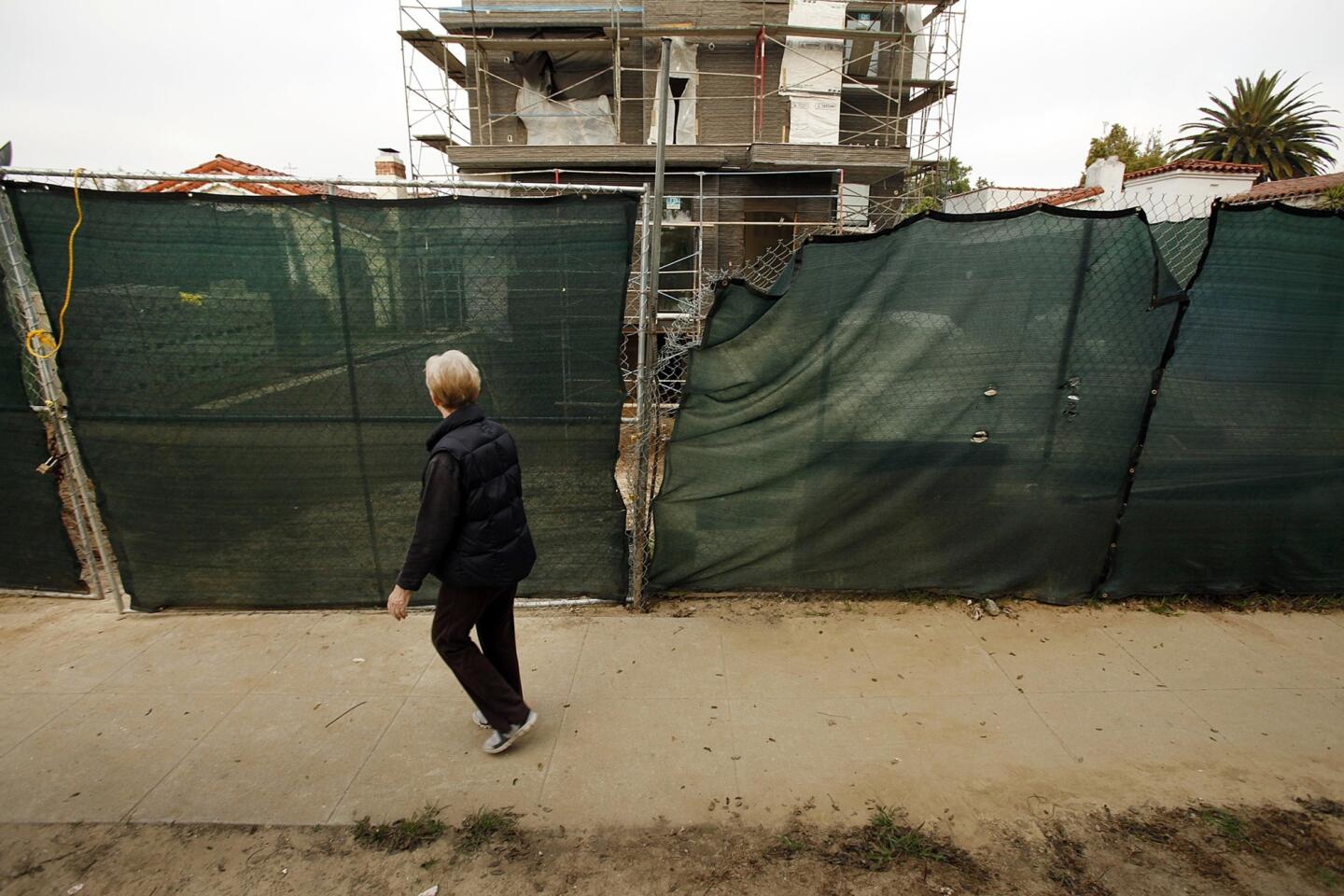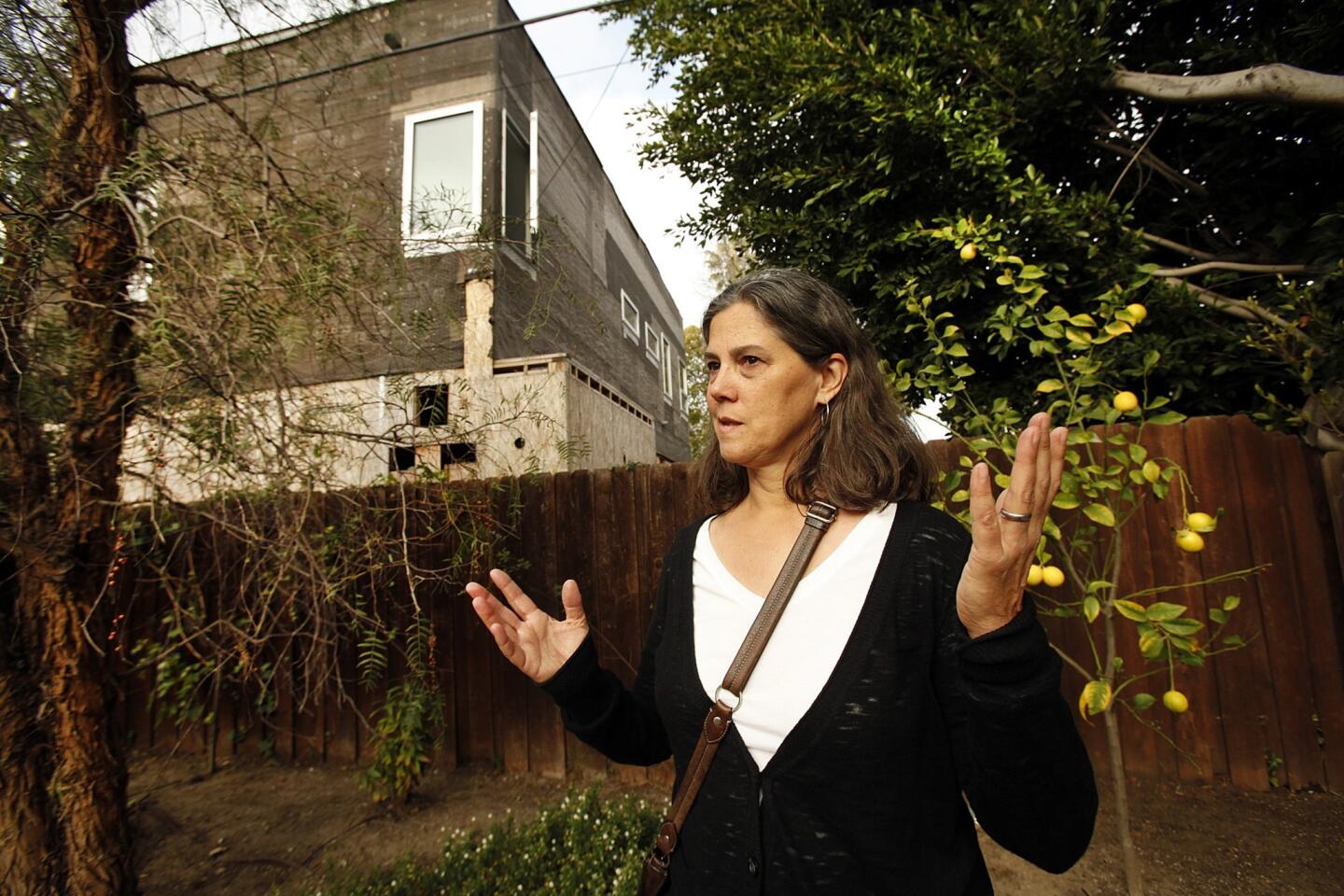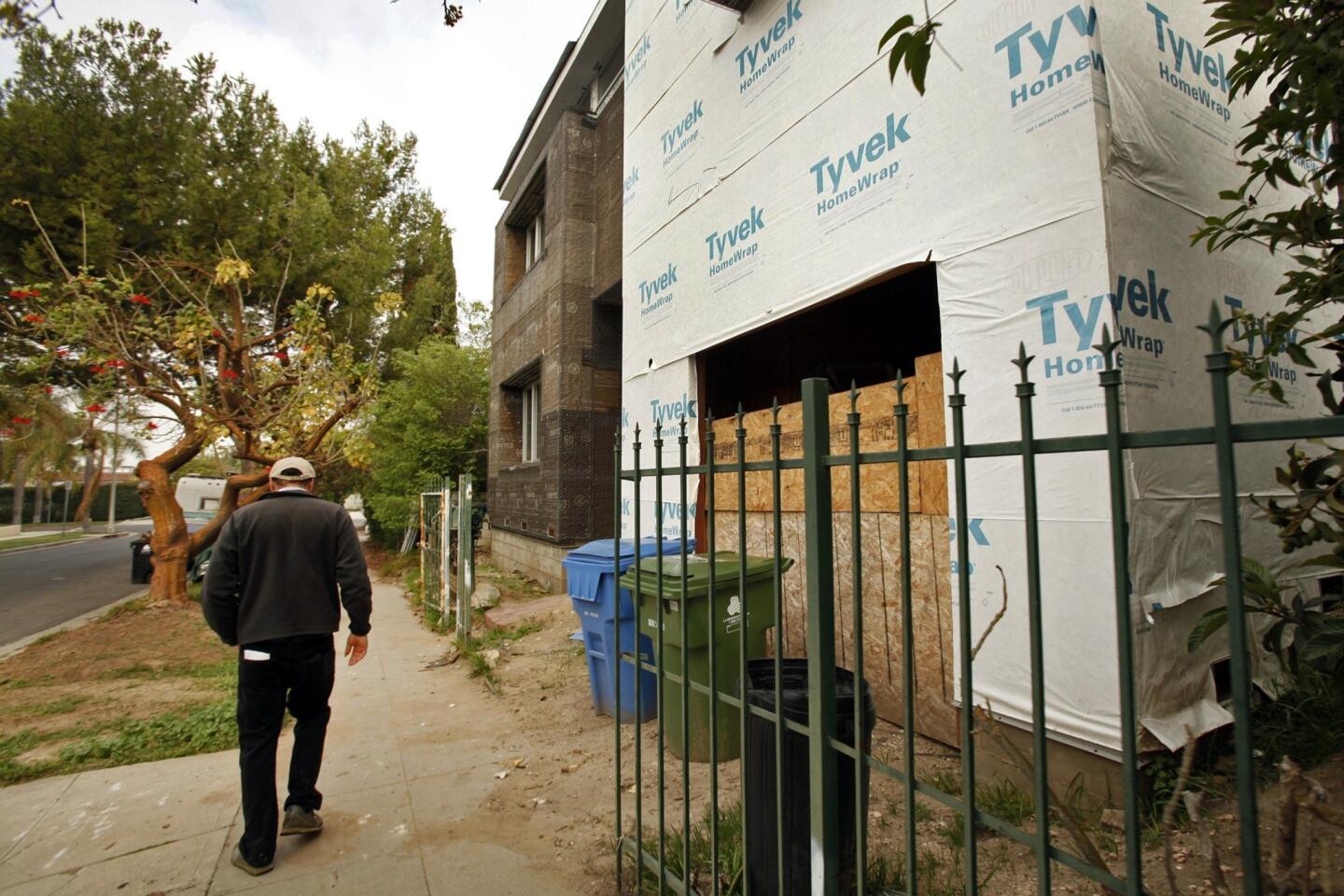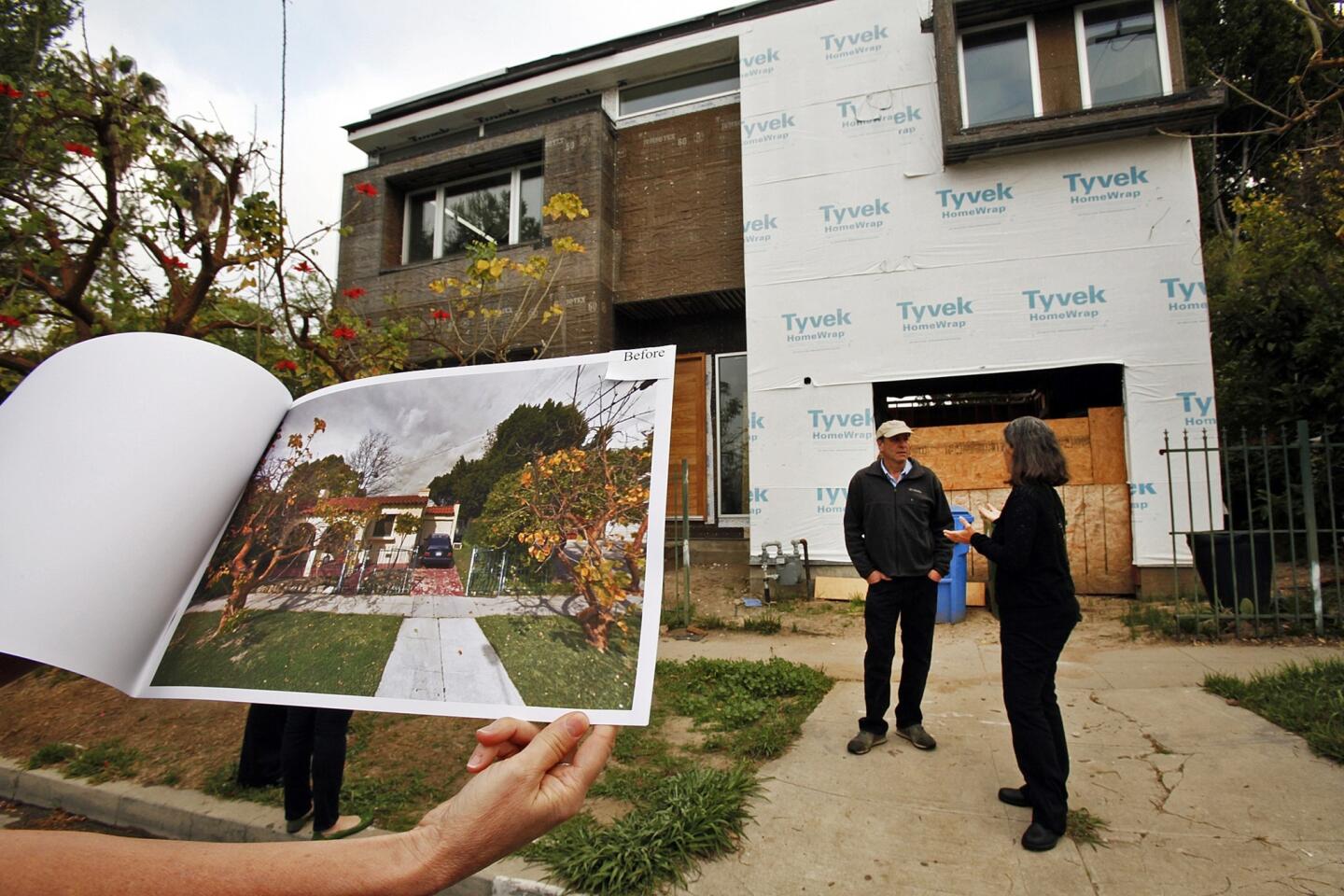Return of ‘mansionization’ has some L.A. homeowners grumbling
- Share via
Six years ago, Los Angeles politicians imposed new limits on the size of new and renovated houses, promising to rein in what they called “homes on steroids” dwarfing blocks of smaller buildings.
But as the housing market rebounds and construction picks up, many homeowners complain that “mansionization” has revved up — reigniting long-standing policy battles and sometimes bitter fence fights over the face and feel of L.A.’s neighborhoods.
Builders are snapping up smaller, older homes, razing them and replacing them with bigger dwellings. Increasingly, sleek, square structures are popping up along streets known for quaint bungalows.
------------
FOR THE RECORD:
Mansionization: An article in the May 5 Section A about “mansionization” in some L.A. neighborhoods identified Daniel Bibawi as an architect. Bibawi said he is a principal with the firm Southern California Architects, but is not a licensed architect. —
------------
Architects and designers behind such projects — and the buyers and homeowners they build for — argue that larger homes are needed to meet the demands of modern families.
But neighborhood groups have begun mobilizing, asserting that rules meant to control building sizes are still too porous. Critics argue that builders have exploited loopholes — bonuses that allow extra square footage — to erect homes too large for their lots. The recent surge of complaints prompted Michael LoGrande, director of the Department of City Planning, to tell lawmakers that more stringent controls might be needed.
In Hollywood, for example, members of a neighborhood group objected to a spec home exceeding 3,000 square feet, being built on a Stanley Avenue block lined with older, smaller homes — most of them under 2,000 square feet. Aggravated by the “out of place, enormous” residence, Amy Aquino of the Sunset Square Neighborhood Assn. said the group hired a land-use consultant to examine how it was allowed.
“Everything they were doing, hideous as it is, is all completely legal,” Aquino said.
The builder behind the home, Amnon Edri, said that as long as his project meets requirements, it shouldn’t be a problem.
“If the city code allows it, and you want a bigger house, you have the right to a bigger house,” he said. “This is America. It’s a free country.”
Neighbors pushing for stricter rules fear that outsized, out-of-character buildings will drag down their home values. Edri and others maintain that bigger homes boost prices for their neighbors.
The tensions also reflect clashing expectations of Los Angeles living.
For decades there was “kind of a consensus about what a Southern California house should look like” — low, rambling and open to the landscape, cultural historian D.J. Waldie said. That philosophy, along with requirements imposed by builders, gave rise to uniform neighborhoods lined with homes of similar sizes and styles, Waldie said.
But in a growing city with scant undeveloped land and changing tastes, some Angelenos see things differently. They look at older neighborhoods and think, “‘this is where the good life is lived,’” Waldie said. “‘But I don’t want to live in a 1,300-square-foot house.’”
The Baseline Mansionization Ordinance was approved in 2008 as the city was slipping into the housing slump. It was meant to stop homes from expanding, as Councilman Tom LaBonge put it, “like the Pillsbury Doughboy.”
Under the new rules, a 5,000-square-foot lot in a typical residential zone generally could not have a home of more than 2,500 square feet of “residential floor area,” including extra buildings — or a total of 50% of the lot size. Before the change, a home of up to 7,000 square feet, not including garages, could be built on the same size lot, according to the planning department.
But the law includes special exceptions. Builders can get a bonus to build 20% or 30% larger than ordinarily allowed if they design their homes to be environmentally friendly, or if they adhere to certain scaling requirements of home facades and upper floors. The home Edri is building on Stanley Avenue, for example, was allowed hundreds of feet of additional floor area because part of the facade was recessed, according to its building permit.
Critics point out that some construction that can bulk up the appearance of residences isn’t counted against the size limits. Up to 400 square feet of “covered parking area” can be excluded from city calculations, for example.
Such exceptions and other bonuses “effectively gutted the ordinance that was supposed to stop mansionization,” said former city planner Dick Platkin, a longtime Beverly Grove resident. He called for the elimination of “little architectural gimmicks that still allow a large, boxy house to be built.”
In his Westside neighborhood and in Studio City in the Valley, where frustration has simmered over such buildings, homeowners successfully campaigned to impose tighter restrictions on home size. Some argue that similar restrictions should be adopted citywide.
That alarms some builders, architects and homeowners. “What happened in Beverly Grove was basically a death sentence to development and real estate in the area,” said Eran Gispan, a designer with N.E. Designs Inc. Similar restrictions citywide would “kill the market completely,” he said.
Architect Daniel Bibawi said that since the tighter Beverly Grove building limits were approved last year, his firm hasn’t had any projects in the area. The families that hire him typically want at least five bedrooms to accommodate two children, a master bedroom, a guest room and an office, he said.
“It’s become a real bear to deal with, from the design point of view,” he said. “People hire you to build what they want. But then you have to tell them — they can’t have what they want.”
In the Mid-City neighborhood of Faircrest Heights, homeowners are going door to door with petitions against “super-sized homes.” Kathleen Clark and Beth Marlis point to a neighboring Pickford Street house, now undergoing a renovation that roughly doubles its size, which they say blocks their sunset views. The two trucked in grown trees to try to preserve the privacy of their yard.
“They said, ‘It’s going to be green, it’s going to make your house worth more ... it’s going to make your neighborhood better,’” Marlis said. “Far from it.”
Under the basic provisions of the anti-mansionization ordinance, the Pickford Street home would be limited to a residential floor area of 1,450 square feet. Owner Jerome Hunter said he was able to increase the approved area to 1,885 square feet by incorporating green construction techniques and technologies, including LED lights and an efficient air conditioner.
“It’s not like I’m building a mansion,” Hunter said. If the rules were any tighter, “It wouldn’t be worth living here. I’d rent it out.
“And you think the property values would be better if there was a renter?” he said. “I’m increasing the value of their property. I don’t understand the problem.”
Mansionization critics contend that under stricter rules, builders could still craft larger homes without blocking light and boxing in neighbors. “None of us are opposed to expansion and development — when it’s respectful of the neighborhood,” said Traci Considine, part of the Neighbors United group in Faircrest Heights.
Farther north, Bob Eisele, vice president of the La Brea Hancock Homeowners Assn., said real estate agents are making cash offers and targeting “the rundown homes and the homes of the elderly.” If “huge, ugly boxes” keep popping up, he argued, “these homes won’t be salable for anything but tear-downs.”
But Realtor Ron Maman, who moved from Beverly Grove to Encino because he couldn’t expand his home for his family, countered that tighter restrictions would hurt home values.
“You’re putting a ceiling on what people can do with their properties,” he said.
Some city leaders believe changes are due: Councilman Paul Koretz said the rules adopted six years ago are too weak. He’s considering proposing stricter citywide rules or pursuing tighter building controls as part of a pilot project in his Westside district.
The anti-mansionization rules were “groundbreaking” when first imposed, said Alan Bell, the city’s deputy director of planning. But as construction rebounds, the swelling number of neighborhoods seeking tighter rules for their areas “suggests that the ordinance could definitely use some fine-tuning,” he said.
More to Read
Sign up for Essential California
The most important California stories and recommendations in your inbox every morning.
You may occasionally receive promotional content from the Los Angeles Times.















